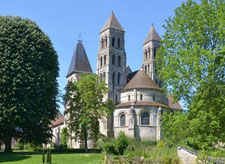Morienval (Oise, France) - Saint-Denis
- Disclaimer
The dating found here is based on the work of John James, and is meant on this site to serve as a starting point. James' dating is derived from a system that uses his interpretation of the development of capitals over time as the basis for chronology, among other factors. His goal is to refine the dating to within years rather than decades. I have not fully embraced James' methodology, and will be developing this page from its current state to one which is admittedly more conservative. The relative expenditure values found in the Timeline are also based on James' work, and I believe these to be reasonably reliable. They are intended only to give a sense of the amount of work involved in each decade.
I have added the idea of the "project" as a way of separating work in buildings. In my mind, a "project" is a discrete section of work in a building that resulted from the one-time acquisition of funding. "Projects" are generally separated by at least a decade where no work was being done. It is my view that it would have been unwise to start a "project" that could not be finished and protected from the elements, and as such a "project" usually involved a wing or multiple wings of a building, from floor to roof. Rural churches, which could only secure small amounts of funding at irregular intervals, often were the result of many small projects, while the great churches, which benefitted from relatively consistent funding, may have involved only a few large projects.
I have added the idea of the "project" as a way of separating work in buildings. In my mind, a "project" is a discrete section of work in a building that resulted from the one-time acquisition of funding. "Projects" are generally separated by at least a decade where no work was being done. It is my view that it would have been unwise to start a "project" that could not be finished and protected from the elements, and as such a "project" usually involved a wing or multiple wings of a building, from floor to roof. Rural churches, which could only secure small amounts of funding at irregular intervals, often were the result of many small projects, while the great churches, which benefitted from relatively consistent funding, may have involved only a few large projects.
- Timeline with Relative Expenditure (if available, in building units)
 |
 |
 |
 |
 |
- Project A - Earlier - Phase 1 -
The tower base in the west with arches to north and south, with little buttresses to west and sides; the west walls of the aisles were butted into them.
- Project B - 1070s - Phase 2 - choir
Choir and transepts with crossing arches where a change in stonework over arches of chapels is more or less in line with start of adjacent window.
- Project B - 1070s - Phase 3 - w tower 1
West tower I
- Project B - 1080s - Phase 4 - w tower II
West tower II
- Project B - 1080s - Phase 5 - nave
- Project B - 1080s - Phase 6 - e tower I
East towers I
- Project B - 1080s - Phase 7 - e tower II
East towers II
- Project B - 1080s - Phase 8 - e tower III
East towers III
- Project B - 1080s - Phase 9 - e tower IV
East towers IV
- Project B - 1090s - Phase 10 - e spires
East towers spires
- Project B - 1100s - Phase 11 - w tower III
- Project B - 1100s - Phase 12 - apse (a)
Apse chapels added between towers with ribs and cells built with walls nd the high vault shafts that were added on the inside of the older walls where there used to have double shafts as in west crossing
- Project B - 1100s - Phase 13 - east (c)
East clerestory wall, capitals and rib vaults
- Project B - 1100s - Phase 14 - east (v)
Completes the vault with the four boss-panels
- Project C - 1160s - Phase 15 - north
North chapel.
- Project D - Later - Phase 16 -
Crossing and nave vaults.
